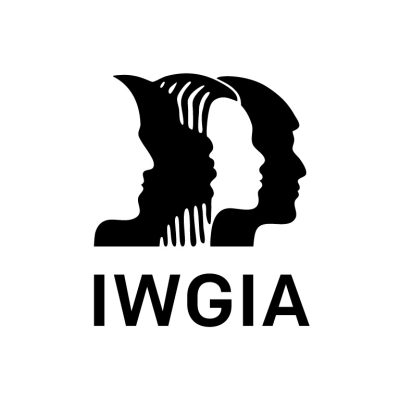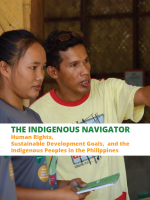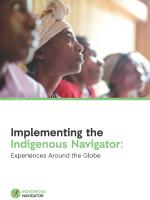Indigenous Navigator: Innovating Indigenous Education through the Small Grants Facility
IS EDUCATION A RELEVANT TOPIC FOR INDIGENOUS PEOPLES?
This report presents the real-life experiences of Indigenous Peoples as they implement pilot projects that address educational needs identified by themselves through the Indigenous Navigator’s small grants facility. It shows how the Indigenous Navigator framework was used to create a data collection tool to monitor progress towards the fulfilment of Indigenous human rights and the global goals –the Sustainable Development Goals (SDGs)– and how, based on those data and with financial and technical assistance from the small grants facility, Indigenous communities came up with project proposals that they are carrying out to improve their wellbeing.
The Indigenous Navigator is an initiative founded by an international partner consortium: Asia Indigenous Peoples Pact (AIPP), the Danish Institute for Human Rights (DIHR), the Forest Peoples Programme (FPP), the International Labour Organisation (ILO), the Indigenous Peoples’ International Centre for Policy Research and Education (Tebtebba Foundation), and the International Work Group for Indigenous Affairs (IWGIA). The Indigenous Navigator is supported by the European Union (EU). Since 2017, the Indigenous Navigator consortium, along with local partners in 11 countries[1] worldwide, have been supporting Indigenous communities’ in their struggles to have their rights fully recognized and respected. The Indigenous Navigator comprises an online portal and a set of assessment tools developed for, and by, Indigenous Peoples to aid the monitoring, implementation and realisation of Indigenous rights. The Indigenous Navigator’s tools, developed with Indigenous Peoples, monitor the implementation of their collective rights. The community-generated data are open and available through the Indigenous Navigator’s online portal.[2]
Indigenous communities and the Indigenous Navigator’s partners were able to analyse the results of 146 validated community surveys (conducted between 2017 and 2019), which led to the creation of 57 data driven, community led pilot projects based on their own priorities and integrated into the small grants facility. Financed by the European Commission (EC), the small grants facility has approved projects that tackle issues ranging from self-determination to citizenship to cultural integrity, among many others. [3]
This report focuses on how the Indigenous Navigator’s small grants facility is supporting innovative solutions to improve Indigenous education. Education is the central topic of this work because of the place education holds in the preservation of Indigenous Peoples’ knowledge, language and culture. These are topics that the Indigenous Navigators’ small grants facility helps Indigenous communities tackle, contributing in this way to existing and upcoming Indigenous projects at the local, national, regional and global levels. Out of the 57 pilot projects that the Indigenous Navigator’s small grants facility finances, 14 are directly related to education, out of which about two thirds involve language teaching or revitalisation. The pilot projects minimise discrimination by increasing access to education, offer new culturally-relevant teaching materials for bilingual and intercultural teaching, help further the professional development and inclusion of Indigenous teachers, facilitate knowledge transfer between Indigenous elders and their communities, and foster the recognition of Indigenous rights regarding the use of Indigenous languages in educational systems.
This document is divided into two parts. The information presented in part 1 is based on the results from the Indigenous Navigator’s data collection process and contextualises the small grants facility, while the analysis in part 2 draws on inedited pilot project submissions, progress reports and personal communications with partnering organisations about the projects. The document analysis includes 14 pilot projects from all 11 countries participating in the initiative: Bangladesh, Bolivia, Cambodia, Cameroon, Colombia, Kenya, Nepal, Peru, the Philippines, Suriname and Tanzania. In addition, this report features four Trends sections, which complement the context(s) of Indigenous education and connect the pilot projects to national, regional and global realities and perspectives. Indigenous Peoples have been involved in planning the 2022-2032 International Decade of Indigenous Languages and in encouraging coherence among international institutions towards the fulfilment of their human rights. The former is at the core of including Indigenous languages in national education systems and studying them at the same level as dominant languages, while the latter is likely to improve Indigenous education policy worldwide.
The Indigenous Navigator’s small grants facility pilot phase intended to take place in 2019 and 2020. Because of the COVID-19 outbreak, some of the pilot projects are still in progress in 2021. The existing results, however, indicate that the pilot projects have transformed major educational issues into real local improvements which are making their way to other localities and other levels. Local, regional and national authorities have shown interest in some of them, and milestones for communities have been achieved regarding language revitalisation.
Introduction - Is education a relevant topic for Indigenous Peoples?
When the United Nations Permanent Forum on Indigenous Issues (UNPFII) was created in 2000[4], Indigenous representatives urged the United Nations (UN) to issue reports that reflected the global situation and priorities of Indigenous Peoples.[5] With that in mind, the United Nations Department of Economic and Social Affairs (UNDESA) has been issuing, since 2009, the report State of the Word’s Indigenous Peoples (SOWIP). The first issue provided an overall view of selected topics which were considered priorities by Indigenous Peoples. Chapter IV was devoted to education, discussing how it is a human right, and how Indigenous Peoples were not achieving the same access to quality education as their non-Indigenous peers worldwide.[6] This first SOWIP edition was released close to the end of the Millennium Development Goals (MDG), the first global agenda for development issued in 2000 and which foresaw, among others, equal access to primary education by 2015.[7] SOWIP’s chapter on education matched the final results of the MDGs in education: while there were huge improvements in access worldwide by 2015, Indigenous Peoples still faced more challenges due to the limitations that national systems had to provide culturally and linguistically relevant basic education for them.[8]
In 2015, the MDGs were replaced by the Sustainable Development Goals (SDGs).[9] Among them, SDG 4 aims to “ensure inclusive and equitable quality education and promote lifelong learning opportunities for all”.[10] SDG 4 has seven targets, one of which (target 4.5) specifically mentions Indigenous Peoples: “by 2030, eliminate gender disparities in education and ensure equal access to all levels of education and vocational training for the vulnerable, including persons with disabilities, indigenous peoples and children in vulnerable situations”.[11] Aware of SDG 4 and target 4.5, UNDESA’s third edition of SOWIP was completely devoted to education.[12] The third SOWIP report explores each Indigenous region of the world and follows up on what the first SOWIP stated.
Global efforts and initiatives on Indigenous education show that education remains a critical priority for Indigenous Peoples. Yet, as SOWIP indicates, there are other more urgent issues that Indigenous Peoples must solve, such as health (SOWIP’s second volume), poverty, or the environment, including land rights.[13] To this regard, the International Labour Organisation (ILO) followed up with a report on how Indigenous Peoples have been seeking social justice and equity to be able to become self-sustainable. Although education is not a main topic in the report, the ILO’s report is important in relation to the theme, because the path towards social justice, equity, and the full enforcement of the right to education for Indigenous Peoples is marked by these issues.[14]
Indigenous Peoples are actively tracking their situation on education, but more, they are also actively involved in international processes related to education. To name a few examples, the UNPFII supported the issuing of SOWIP and its third volume on education; Indigenous Peoples have continued to advocate and work consistently to successfully achieve their explicit mention in the SDGs; a current point in the Indigenous agenda is to create disaggregated data on education that allow the monitoring of their situation and feed the SDGs. In 2008, Tebtebba Foundation issued a compilation of reports from international meetings where Indigenous Peoples discussed how they envisioned the monitoring of their human rights. Education was a recurrent theme in the discussions, usually accompanied by cultural integrity, as well as language preservation and revitalisation.[15]
More recently, in 2016, the UNPFII issued a Backgrounder on the SDGs which specifies that the 2030 Agenda for Development mentions Indigenous Peoples six times, one of which is SDG 4.[16] However, the Backgrounder also identifies how the Agenda oversees collective Indigenous rights –especially their right to develop their own educational systems–, cultural sensitivity in education, national data disaggregation, and cooperation with member states to make progress towards achieving SDG 4.[17] In 2019, the Indigenous Peoples Major Group (IPMG) issued a position paper for the High Level Political Forum (HLPF) on the SDGs where discrimination against rural Indigenous children in terms of their access to education, lack of use of Indigenous mother tongues for teaching, devaluation of traditional Indigenous knowledge, lack of culturally sensitive curricula, and geographic and financial challenges to pursue higher education were identified as obstacles to achieve SDG 4.[18] All in all, education is more than a relevant issue to Indigenous Peoples, but they still struggle to improve it.
Read the full report at the link to the right.
[1] Kapaeeng Foundation, from Bangladesh; Centro de Estudios Jurídicos e Investigación Social (CEJIS), from Bolivia; Cambodia Indigenous Peoples Organization (CIPO), from Cambodia; Association OKANI, from Cameroon; Organización Nacional Indígena de Colombia (ONIC) and Centro de Cooperación al Indígena (CECOIN), from Colombia; Mainyoito Pastoralists Integrated Development Organization (MPIDO) and Indigenous Livelihoods Enhancement Partners (ILEPA), from Kenya; Lawyers’ Association for Human Rights of Nepalese Indigenous Peoples (LAHURNIP), from Nepal; Organización Nacional de Mujeres Indígenas Andinas y Amazónicas del Perú (ONAMIAP) and Perú Equidad – Centro de Políticas Públicas y Derechos Humanos, from Peru; Indigenous Peoples’ International Centre for Policy Research and Education (Tebtebba Foundation), from the Philippines; Association of Indigenous Village Leaders in Suriname (Vereniging van Inheemse Dorpshoofden in Suriname – VIDS), from Suriname; Association for Law and Advocacy for Pastoralists (ALAPA) and Pastoralists Indigenous Non-Governmental Organization’s Forum (PINGO’s Forum), from Tanzania.
[2] Romina Quezada Morales, Dialogue and Self-Determination through the Indigenous Navigator (Copenhagen, DK: International Work Group for Indigenous Affairs, 2021), accessed 27 March 2021, https://www.iwgia.org/en/resources/publications/3990-dialogues-in-iwgia.html
[3] Ena Alvarado Madsen and David Nathaniel Berger, Implementing the Indigenous Navigator: Experiences Around the Globe (Copenhagen, DK: International Work Group for Indigenous Affairs, 2020), accessed 26 October, 2020, https://nav.indigenousnavigator.com/images/documents-english/Reports/Reports2020/Implemeting_the_indigenous_navigator.pdf
[4] Economic and Social Council, “Establishment of a Permanent Forum on Indigenous Issues” (New York: United Nations, 2000).
[5] United Nations Department of Economic and Social Affairs (UNDESA), “State of the World’s Indigenous Peoples, First Volume” (September 8, 2009), accessed 16 January, 2021, https://www.un.org/development/desa/indigenouspeoples/publications/2009/09/state-of-the-worlds-indigenous-peoples-first-volume/
[6] United Nations Department of Economic and Social Affairs (UNDESA), State of the World’s Indigenous Peoples (New York: United Nations, 2009), accessed 16 January, 2021, https://www.un.org/esa/socdev/unpfii/documents/SOWIP/en/SOWIP_web.pdf
[7] United Nations, “Goal 2: Achieve universal primary education”, accessed on 16 January, 2021, https://www.un.org/millenniumgoals/education.shtml
[8] UNESCO, Education for All Global Monitoring Report 2000-2015: Achievements and Challenges (Paris, France: UNESCO, 2015), accessed 16 January, 2021, https://www.right-to-education.org/sites/right-to-education.org/files/resource-attachments/EFA%20Global%20Monitoring%20Report%202015.pdf
[9] United Nations General Assembly (UNGA), “Transforming our World: 2030 Agenda for Sustainable Development” (2015), accessed 14 January, 2021, https://www.un.org/en/development/desa/population/migration/generalassembly/docs/globalcompact/A_RES_70_1_E.pdf
[10] Idem.
[11] Idem.
[12] United Nations Department of Economic and Social Affairs (UNDESA), State of the World’s Indigenous Peoples. Education. (New York: United Nations, 2008), accessed 16 January, 2021, https://www.un.org/development/desa/indigenouspeoples/wp-content/uploads/sites/19/2017/12/State-of-Worlds-Indigenous-Peoples_III_WEB2018.pdf
[13] United Nations Department of Economic and Social Affairs (UNDESA), State of the World’s Indigenous Peoples (New York: United Nations, 2009), accessed 16 January, 2021, https://www.un.org/esa/socdev/unpfii/documents/SOWIP/en/SOWIP_web.pdf; United Nations Department of Economic and Social Affairs (UNDESA), State of the World’s Indigenous Peoples. Health. (New York: United Nations, 2014), accessed January 16, 2021, https://www.un.org/development/desa/indigenouspeoples/wp-content/uploads/sites/19/2018/03/The-State-of-The-Worlds-Indigenous-Peoples-WEB.pdf
[14] International Labour Organisation (ILO), Implementing the ILO Indigenous and Tribal Peoples Convention No. 169. Towards an inclusive, sustainable and just future (Geneva, Switzerland: ILO, 2019), accessed 17 January, 2021, https://www.ilo.org/wcmsp5/groups/public/---dgreports/---dcomm/---publ/documents/publication/wcms_735607.pdf
[15] Tebtebba Foundation, Indicators Relevant for Indigenous Peoples: A Resource Book (Manila, Philippines: Tebtebba Foundation, 2008).
[16] United Nations Permanent Forum on Indigenous Issues (UNPFII), “Indigenous Peoples and the 2030 Agenda Backgrounder” (2016), accessed 12 January, 2021, https://www.un.org/development/desa/indigenouspeoples/wp-content/uploads/sites/19/2016/08/Indigenous-Peoples-and-the-2030-Agenda.pdf
[17] Idem.
[18] Indigenous Peoples Major Group (IPMG), “High Level Political Forum for Sustainable Development 2019, Statement of the Indigenous Peoples Major Group (IPMG), GOAL 4: Quality Education for All”, accessed 14 January, 2021, https://www.indigenouspeoples-sdg.org/index.php/english/all-resources/ipmg-position-papers-and-publications/ipmg-statements-and-interventions/120-hlpf2019-statement-of-the-indigenous-peoples-major-group-goal-4-quality-education-for-all/file

Contact





